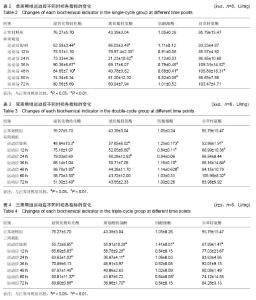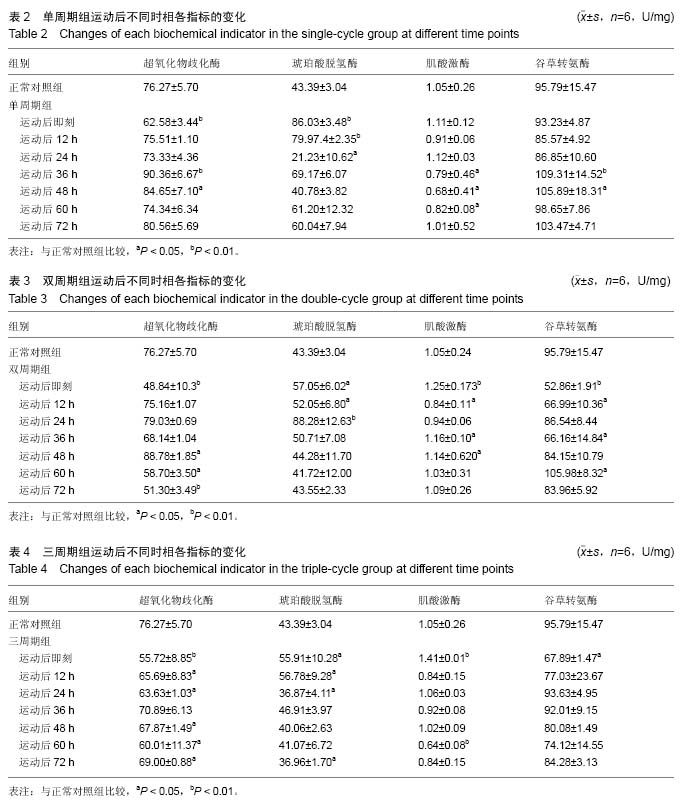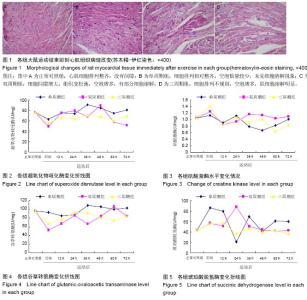| [1] 殷劲,岳建兴,周进,等.糖酵解供能运动后“超量恢复区间”的研究[J].成都体育学院学报,2007,33(4):88-91.
[2] 王广虎,余革.超量恢复与超量恢复训练原理的审视与思考[J].成都体育学院学报, 1997,24(2):19-21.
[3] 胡尧.实验用鼠游泳负重装置[P].中国发明专利, 201310305987.3,2015-01-23.
[4] 姜燕,殷劲,武俸羽.糖有氧运动后骨骼肌超量恢复的相关研究[J].当代体育科技,2014,4(8):21.
[5] 常芸,林福美,陈小同,等.运动心脏重塑的发生与转归[J].体育科学,2000,20(5):46.
[6] 侍勇.不同强度的运动对心脏的影响[J].南京体育学院学报,2004,3(1):22-25.
[7] 刘振玉.运动训练与肌酸激酶研究进展[J].天津体育学院学报,1999,14(2):30-32.
[8] 彭峰林,曹志发.运动训练对大鼠心脏内分泌和内源NO的影响[J].中国运动医学杂志, 2003,22(6):558-559.
[9] Mikami T,Sumida S,Ishibashi Y,et al.Endurance exercise training inhibits activity of plasma GOT and liver caspase-3 of mice [correction of rats] exposed to stress by induction of heat shock protein 70.J Appl Physiol (1985).2004;96(5):1776-1781.
[10] 田振军,熊正英.过度训练对大鼠心肌局部CK、AST及其同功酶和SOD、LDH活性影响的研究[J].北京体育大学学报,1999,22(4):38-40.
[11] 池爱平,熊正英.服用不同剂量姜黄素对大鼠血清酶及肝、心肌组织运动损伤的影响[J]. 营养卫生,2005,26(8): 364-366.
[12] 袁剑锋,常芸.运动心脏重塑过程中西部凋亡现象的活细胞观察[J].中国运动医学杂志,2001,20(4):348-350.
[13] 张均,杨小英,等.运动队心肌线粒体钙和细胞色素C的观察[J].体育科学,2003,23(2): 130-133.
[14] Urhausen A,Gabriel HH,Kindermann W.Impaired pituitary hormonal response to exhaustive exercise in overtrained endurance athletes.Med Sci Sports Exerc. 1998;30(3):407-414.
[15] Nakatani T,Nakashima T,Kita T,et al. Succinct dehydrogenises activities of fibers in the rat extensor digit rum long us, soles, and cardiac muscles.Arch Histol Cytol. 1999;62(4):393-399.
[16] 毕秋芸,彭莉,王启荣.递增负荷训练后大鼠血清CK及其同工酶、LDH、ALT、AST活性变化[J].中国运动医学杂志,2006,25(5):593-595.
[17] Huertas R,Campos Y,Díaz E,et al.Respiratory chain enzyme in muscle of endurance athletes.Biochem Biophys Res Commun.1992;188(1):102-108. |



